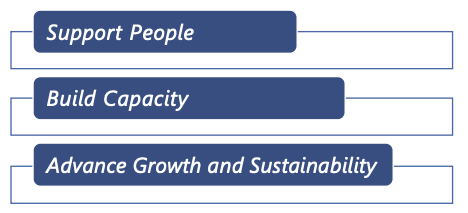Digital CEDS
Southeastern Connecticut Enterprise RegionExecutive summary
Southeastern Connecticut Enterprise Region (seCTer) presents a Comprehensive Economic Development Strategy (CEDS) for the Southeastern Connecticut Economic Development District (SECT EDD) which has three goals:

This CEDS (CEDS 2023) consists of a set of strategic goals and actions which will help the region become more resilient, equitable, attractive, wealthy and competitive. Southeastern Connecticut Enterprise Region (seCTer) is the facilitator, or steward, of the strategic goals and actions, but one organization cannot do it alone: the creation of CEDS is a shared exercise. The development of CEDS 2023 included formal and informal input by municipal, community and business leaders; hard and dedicated work by the seCTer Board and several of its working committees; and public input throughout the region via a regional survey, a series of focus groups, and one-on-one targeted interviews with six subject matter experts.
The U.S. Economic Development Administration (EDA) defines CEDS as follows: “Creating the conditions for economic growth and improved quality of life by expanding the capacity of individuals, businesses, and communities to maximize the use of their talents and skills to support innovation, job creation, and private investment.” Two important threads run throughout CEDS 2023: equity and resilience. However, no section of CEDS 2023 is specifically labelled Equity or Resilience as these foundational concepts should be and are paramount and integrated throughout CEDS 2023.
There are goals that specifically address financial mobility and accessibility, with a focus on those who traditionally have had difficulty accessing capital to start a business. There are goals that center on ensuring businesses and communities are more resilient against potential economic shocks such as the Covid-19 pandemic. And while some goals and actions may seem vague now, some clarity will surface over time as an implementing framework is put in place. If not, CEDS 2023 can be amended, as it is intended to be a dynamic and flexible plan geared specifically to Southeastern Connecticut.
Why Support People as a goal? The definition of CEDS uses the phrases “capacity of individuals” and “their talents and skills.” People need to be afforded the ability to make positive choices that can positively impact their lives. It is not beyond the focus of economic development to ensure that educational structures are in place so that an individual can get the training needed to obtain a good paying job. Moreover, the business that has that good paying job needs to operate in an environment where it can thrive, grow and need new employees.
Another person’s path to financial mobility might be through entrepreneurship. Conditions in the region need to be such that entrepreneurs, despite geography or demographic background, can thrive. The Support People objective: Ensure there are equitable opportunities, programs and quality housing at accessible rates in place so that existing residents can make decisions that will positively affect their lives, and develop strategies to attract new, civically-engaged people who will participate in the workforce or start new employer businesses.
Why Build Capacity as a goal? The region needs human capacity and capital due to an aging workforce and population. The region needs greater financial capacity and sophistication so that projects can move from ideas to execution. The region needs more knowledge capacity so that economic development becomes better understood as a means to increase quality of life. The Build Capacity objective: Build economic development capacity and awareness throughout the region so that the region can become more resilient, equitable, attractive, wealthy and competitive.
Why Advance Growth and Sustainability as a goal? The past three years have amplified the region’s need to think more deeply about how the region can be in the best possible position to succeed. Historically, the region has only considered climate threats, but in the span of three years the region has experienced health and economic shocks, and now, at the time of this writing, significant inflation. The region needs to be better prepared to anticipate and withstand a wide variety of shocks. The Advance Growth and Sustainability objective: Uplift the region’s ability to withstand national or international economic shocks, loss of significant employers, or climate-related shocks by making the region more aware of risk and increasing its ability to respond.
The pages that follow capture and highlight some – certainly not all – of the relevant activity since CEDS 2017. There is information that depicts where the region is currently from a demographic, employment, wage and industry well-being perspective. There is information which provides insights into data and opinions shared for the creation of this document, specifically the perceived strengths, weaknesses, opportunities and threats facing the region. The data and public engagement inform the goals and strategies which will be seCTer’s focus for the next five years.

Paul Whitescarver
Executive Director, Southeastern Connecticut Enterprise Region

Sean Nugent
Board Chair, Southeastern Connecticut Enterprise Region
